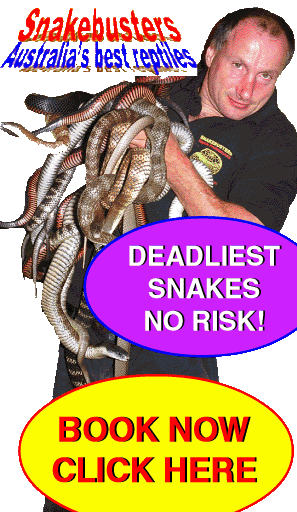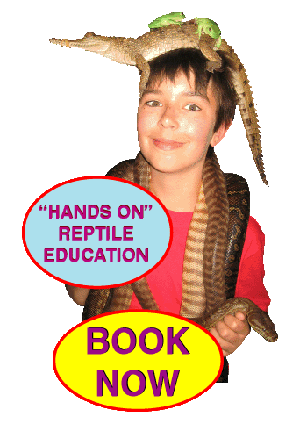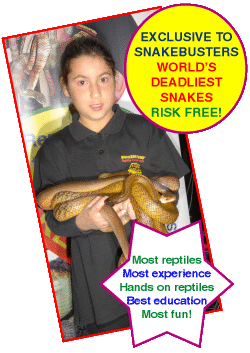

The Snakebusters reptiles
… always top quality.
(read the details below).
We don't just have the best, most entertaining and most educational
shows and lectures that money can buy, but we also have the best reptiles!
Our reptiles are always top-notch and kept in immaculate condition.
All snakes and lizards are routinely treated for all known internal and
external parasites.
As a rule, our snakes are fed only food that's been held in the freezer
for at least 4 weeks to further reduce parasite risks to them. They are
all only fed dead food so as to eliminate injury risks from prey items.
Death of our reptiles from anything other than old-age related ailments
is effectively unheard of. Our skills as reptile keepers and pioneers of
new techniques is world renowned.
For example, Snakebusters (Raymond Hoser) was the first (in 2003) to diagnose
and positively identify a previously unknown reovirus that was wiping out
reptiles in collections across Australia, including at some of the best
known zoos.
At Hoser's facility the virus spread was stopped in it's tracks and unlike
for all other affected facilities that simply did nothing effective to
stop mass die off's, Hoser rapidly developed an effective means to deal
with the virus and prevent what until then had been certain death for vulnerable
affected reptiles.
As a result, a vulnerable snake affected by the reovirus, that formerly
faced certain death can now be saved via a (now) routine treatment that's
been developed (see Hoser 2003a and 2003b).
The reptiles we use in our shows are always well adjusted, used to being
handled and "clean".
For internal parasites all incoming reptiles are quarantined and treated
with Panacur, Flagyl and Droncit, (known as the trifecta) even if there
is no obvious evidence of the relevant parasites.
For external parasites, such as the dreaded snake mites, we use dichlorvos-based
and pyrethrin-based chemicals. This exoparasite treatment is repeated periodically
due to the exposure of our show animals to these animals (mainly the lizards
via hand touch with people who may carry the parasites from their own reptile
pets).
The above treatments eliminate virtually all known reptile parasites, the
most notable exception being pentastomid worms, which are generally commensal
to reptiles, not harmful.
In the unlikely event that a parasite or ailment has been missed by our
proactive treatments, they are treated accordingly.
All our reptiles have numbers (not names) and we keep accurate records
of growth, feeding, breeding and all other important aspects of their lives.
This information is databased and besides giving us any reptile's past
history "on demand", it also forms the basis for comparisons
between reptiles and the basis of scientific studies, including some of
those reposted on the internet at: http://www.herp.net.
We rarely restrict handling of given reptiles due to the lack of evidence
of stress caused by it.
However reptiles known to be pregnant (gravid) are not shown during this
period.
Venomoid Snakes:
These are the ones who have had their venom glands surgically removed
to remove risks to handler and public during live shows.
In terms of the operation itself, we use the most up-to-date methods as
documented by Hoser (2004).
Short term pain experienced by the snakes through the operation itself
that have been operated on is minimal and the long-term benefits to the
said snakes far outweigh this short term discomfort.
There are no adverse effects known on the relevant snakes, however advantages
of the venomoid state include elimination of (adverse) bite risk from one
snake to another of different species if and when they are put togeather
during a show (for comparison purposes) or if transported togeather.
No other snake exhibitors in Australia have this safety feature for their
snakes and hence run the real risk of snakes killing one another, and yes
it is a periodic event for other venomous snake exhibitors.
You see, as a rule, snakes are not immune to venoms of other species.
More importantly, the venomouid state allows the snakes to be handled more
casually by the handler, due to the elimination of adverse bite risk, the
result being that the snakes reciprocate in kind and in turn become more
tractable and well-adjusted.
The need to inflict pain on the said snakes with heavy sticks and hooks
to handle in accordance with their venomous state is eliminated by the
venomoid operation.
Hence handling of these snakes for shows becomes a stress-free experience
for the snakes, which is a result only (safely) attainable by use of the
venomoid operation. The benefits of the venomoid state go far beyond what is seen by the public in the shows. Off-display, snakes need to be cleaned, moved about, their cages or boxes cleaned and all regularly inspected. It is here that the benefits of the venomoid state for the snakes realy becomes apparant and manifests in better adjusted reptiles that are in no fear of humans poking, necking and hooking them as would otherwise be the case.
So obvious are the benefits of the venomoid state that in 2004 alone, Raymond Hoser/Snakebusters received over 200 requests from people with venomous snakes to perform the venomoid operation on their snakes, including at least three other (rival) reptile demonstrators. (For legal reasons we are unable to operate on other people's reptiles or trade venomoid snakes).
The only known affect of handling well-adjusted reptiles for shows and
the like is that the extra movement seems to work up an appetite.
Hence the day after a show (or string of shows) tends to result in voracious
reptiles devouring any food put in front of them.
We are not a zoo!
Snakebusters do not claim to be a zoo. We do not have Polar Bears, Elephants, Giraffe's Hippos, or other animals you'd expect at a zoo. Don't expect to see a Walrus at your house if you call Snakebusters! Snakebusters are pretty much all reptiles and there are two reasons:
1 - Our expertise is greatest with them and we have the best in the business.
2 - No other animals are as popular and while most of our shows are 60 minutes, we can easily fill a 2 hour session with different reptiles and still run out of time! When we've dabbled with insects and the like, people simply cry things like "cut the small stuff and lets have the reptiles!"
In terms of their welfare, our reptiles have numerous advantages to their health and welfare by not being in a zoo. Without putting zoos down (you see we like them), the fact is that they have to operate within certain management and public opinion constraints. In terms of the reptiles, this usually means naturalistic looking cages (always with at least one hiding spot), usually built into the wall of passageways and the like. Besides making the reptiles difficult to observe for the casual visitor, the reptiles themselves may not be in optimal surroundings for health and welfare. Strange as it sounds, the bush is not neccessarily the best place for an individual reptile!
Transmission of exoparasites in zoos (snake mites) is ubiquitious due to transmission from the public (those with pet reptiles merely leaning on a wall can transmit these pathogens) and the logistical difficulties of constantly fumigating buildings. (We fumigate our reptiles in their transport boxes at the end of each showing day, thereby keeping our facility mite free, which is a situation many public zoo curators genuinely envy. This is also why ventilation in our transport boxes is kept to a minimum ... it's for the welfare of the reptiles!).
Reptiles caged in groups (more than one per cage), tend to suffer stress due to the fact that reptiles hate each other more than they hate humans. This is due to social interaction between reptiles, dominance factors and the like. However exhibiting zoos tend to group animals in cages for several reasons, not the least being the need for the public to see at least one non-hiding reptile (otherwise the zoo management start to get complaints like "I can't see anything", or "Is it in there?").
Due to disease management protocols and other health and welfare issues, most captive reptiles are best kept in simple plastic cages with minimal furnishings, making it easy to keep scrupulously clean and strictly one reptile per cage, except when breeding. Rack systems are used when large numbers are being kept. These cages do not look particularly attractive to people who expect to see reptiles in a "Bush setting" and if these cages were seen in a public zoo, may upset aninmal rights activists wondering about the lack of "natural surroundings" for the reptiles. However the reptiles themselves prefer these cages and even "off display" most zoos actually house their reptiles in a similar way.
Snakebusters have a state of the art set-up in two large buildings (with a total of six rooms) on a large treed estate in Melbourne's Green Wedge (Park Orchards). Yes the cages themselves are also individually climate controlled as well. A sizeable third building is used to store materials. The Hoser residence (a fourth building) is on a separate part of the property so that the reptiles can be attended to 24/7 if needed.
The reptile rooms are temperature controlled individually to fix potential minimum and maximum temperatures (regardless of outside fluctuation) and each cage is also controlled separately to ensure correct max and mins at either end of the cages (hot and cool ends) as well as individually controlled diurnal (day/night) cycles for light and/or temperature. The day-to-day management of the reptiles is effectively automated and so advanced that snakebusters are leaders not just in showing reptiles in prime health and condition, but also in terms of breeding the very same animals. In fact we often have trouble getting rid of our young because we breed so many! Many methods pioneered by Raymond Hoser over the last three decades are now reptile industry standards. In terms of reptile showing, we often run our entire facility on "reverse cycle" meaning the reptiles day/night cycle is reversed. This enables us to feed our reptiles at the end of each day (now their morning) and them to be able to digest their food by the next morning's showing (their evening), allowing them to run in shows daily for months on end and with no adverse effects. This wouldn't be possible if we ran the reptiles on a diurnal cycle in synch with the outside world. We tend to breed all species for which we have adult pairs. This includes Tiger Snakes, Red-bellied Black Snakes, Death Adders and Eastern Brown Snakes, the mating males of which are seen at shows more than 250 days a year!



http://www.snakebusters.com.au/sbsboo1.htm
Bookings and urgent inquiries please phone:
(Melbourne, Victoria, Australia):
(03) 9812 3322 or 0412 777 211


All rights reserved.
Snakebusters is a registered trademark in several categories and jurisdictions, including specifically for snakes in Melbourne, Melbourne reptiles, snake and lizard events, crocodiles in Melbourne, deadly snakes in Melbourne, reptile keeping in Melbourne and Victoria. Unauthorised use, misuse, dilution or other activities relating to the trademarks is prohibited, including in Melbourne, Victoria, Australia or anywhere else where we exercise trademark rights and intellectual property rights.This includes for:
snakes Melbourne, Melbourne reptiles, snake and lizard events in Melbourne Victoria, pet reptiles Melbourne, reptiles as pets, deadly snakes in Melbourne, reptile keeping Melbourne Victoria